Email copywriting is tricky.
You see, most people skim their emails — you know you do it, too!
And as an email copywriter, you must grab the reader’s attention and keep them engaged.
Easier said than done, right?
Now, the great news is that there are proven tricks to help your emails stand out.
And below, I’ve highlighted the 11 best email copywriting tips guaranteed to boost your open and conversion rates.
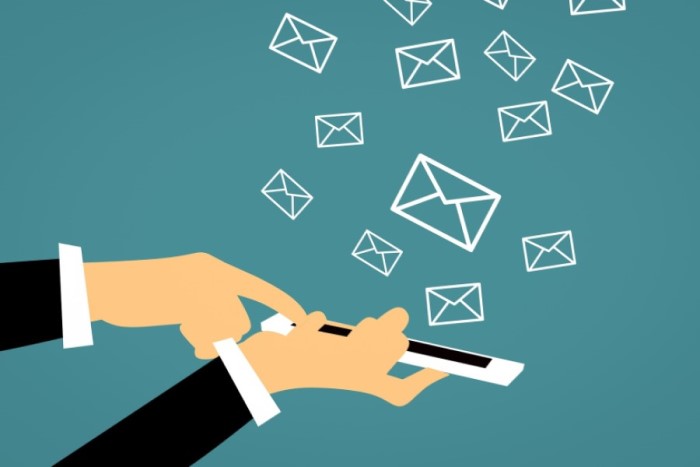
What is Email Copywriting?
Email copywriting is a type of copywriting used in email marketing. Basically, it’s the “written” part of a marketing email.
Now, a well-written email offers value or tells recipients why they should do something and convinces them to take action. Put more bluntly, a well-written email persuades potential customers to convert.
Every good email copywriter has strong writing skills and knowledge of the target market. They must also understand email marketing principles like split testing, personalization, and metrics.
Email marketing is vital to your business because it’s one of the most effective ways to reach customers and prospects. With email marketing, you can:
- track marketing emails to see what resonates with readers and what doesn’t
- personalize email copy to target people’s interests or past purchases
- send regular emails to your subscribers, telling them about new products or services
- send valuable information that’s useful for your target audience and helps you build a relationship with them
- establish your authority and educate prospective and current clients about your field of expertise
If you want to learn how you can make your email copy irresistible, these proven practices will help you elevate your email marketing.
Let’s take a look.
11 Proven Email Copywriting Tips That Will Convert Like Crazy
Below, you’ll find a few proven email copywriting best practices that’ll help you create more successful email marketing campaigns. This is by no means a complete list. But in our experience, these tips will drive the most meaningful results.
1. Have a Clear Purpose for Each Email
Each sales email you write should have only one purpose or objective.
You want people to do something. It could be to buy a product, sign up for a newsletter, follow you on social media, or download an ebook.
Too many different thoughts — read this blog post, buy this product, visit this link, listen to this podcast — will confuse and overwhelm the reader. Instead, focus on one objective you want to cover throughout your email copy.
For example, if you’re selling a new product via email, your entire email should be about the new product. Tell readers what the product is and how it can help them. Then make sure there’s a clear call to action at the end to get them to click through to the sales page.
2. Address Reader Needs and Benefits
Your email campaign needs to focus on the reader’s needs. What can you offer that will excite readers?
Make them look forward to receiving your emails by giving them the information they want and need. It doesn’t have to be in the email copy itself. You could direct them to a blog post, a YouTube video, or a social media page where they can get more help.
The more value you give your reader, the more likely they will continue reading your emails.
For example, if you sell insurance, don’t send a generic email newsletter to all your email subscribers asking them to contact you for a quote on life insurance.
Instead, ask them if they need help to protect their assets or if they need assistance with an existing life insurance policy. Show them you want to help. Use the information you gather to tailor the emails to their needs. Depending on the responses, you might send an email with tips on how to save money on life insurance or how to save money on their homeowner’s policy.
3. Make it Personal
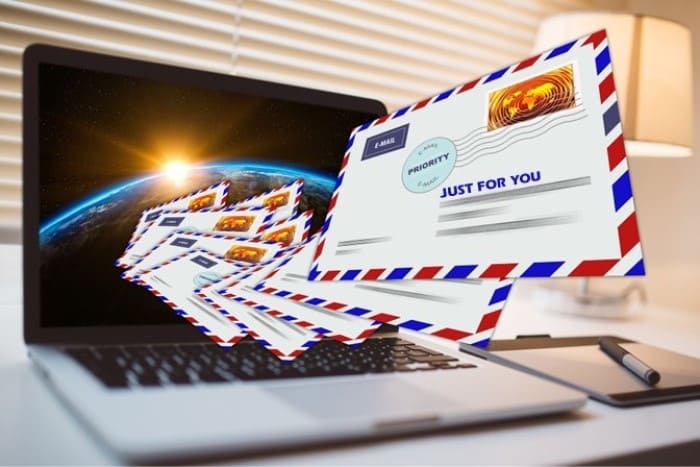
Personalize the email copy you send to your subscribers.
If you ask for their name when readers sign up to your list, use their names in your email salutation.
Personalize your message based on the information you have about your readers. If you know what they bought the last time they visited your website, use that to personalize the sales email you send to them.
Maybe set up a marketing automation that answers FAQs. Or send a series of emails that educates potential customers about how to get the most from their purchase.
Segment your list and email them only about the things that apply to them. For example, if you’re launching a course, you don’t need to send your launch emails to current students.
4. Keep it Short
Readers are busy people and don’t have time to read through a long sales email, especially if the content is irrelevant to them.
Most readers prefer concise messages they can scan. If you have a lot of information to share, consider breaking it up over multiple emails.
Something else you can do is use bullet points for relevant details. Bullets lend themselves to shorter, scannable text while attracting attention to important information.
As with anything else, you need to test this with your audience. Your audience may enjoy and resonate with longer emails, especially if that’s part of your brand style.
5. Craft an Irresistible Subject Line
You only have one chance to make a first impression on your reader, so make sure you spend time crafting your email subject line.
It’s the most important thing you’ll write in your email, and it determines if your readers keep reading.
Your subject line should offer something of value to the reader. What will they find inside that makes them eager to read the rest of the email?
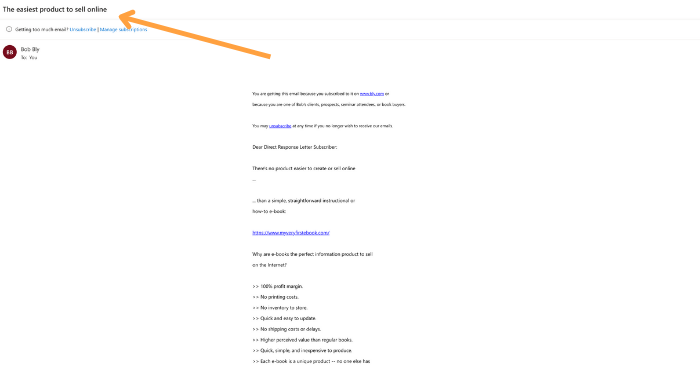
Look at the subject line on this email from legendary copywriter Bob Bly:
The easiest product to sell online.
What’s the value to the reader? If they open the email and read it, Bob promises to tell them which product they can easily sell online. Very simple. But if you’re in the target audience, very impactful.
Test different email subject lines to see which types generate the most opens for your audience.
You can do this by splitting your email list in half. Send half of your list the email with Subject Line A. Send the other half the same email copy, but with Subject Line B. Track which subject line has a higher open rate and use this to inform your next email campaign.
6. Add Compelling Preview Text
An email preview text shows up under the email subject line.
If you’ve written an exciting subject line, chances are good the person will open the email and read it. But what else can help? That little snippet of text tells them what your email is about.
Use power words that draw the reader in. You want the reader to be curious enough to open the email. So write compelling preview text that entices subscribers to click. Don’t use dull or generic words to describe your message. Instead, add a little spice to your description so they want to keep reading.
For example, instead of just saying Here’s your newsletter, as your preview text, say something like The top ways to grow your small business. Or The most popular types of Facebook ad campaigns for small business owners.
7. Write Relevant, Engaging Body Copy
Now you need to write the body of the email.
When you’re writing emails, be conversational. Write in a tone similar to how you speak when talking to a friend.
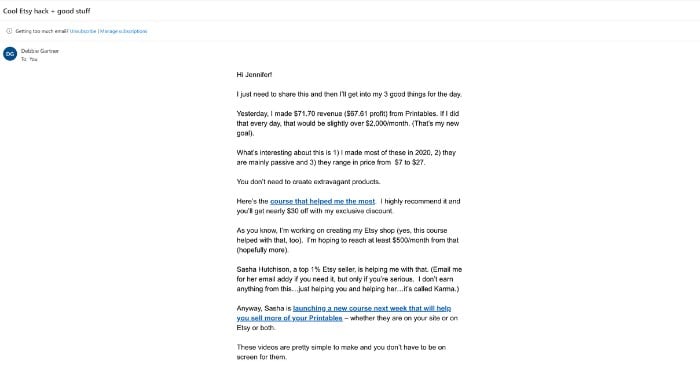
One of my favorite examples is Debbie Gartner’s emails. Her writing is much like having a conversation with someone over coffee. She builds rapport with each reader and appears approachable and friendly. It’s part of why she is so successful. They like receiving a letter from a good friend.
People feel like they’re getting to know you when you write this way. And please, be yourself. Your readers can tell if you’re being fake. And they won’t be interested in doing business with someone who isn’t genuine and trustworthy.
Remember, the best way to sell to someone is by helping them. Give them valuable information they can use to make their lives better.
8. Offer a Clear Call to Action
If you want your readers to do something after reading your email, tell them.
You might think it’s obvious they should go listen to your latest podcast episode. But people are busy and have limited attention spans. Tell them, Go listen to my latest podcast. It will help you do XYZ.
Or, let’s say you’re trying to gather reviews from satisfied customers. You could email people on your list who had shopped with you before and ask them to write a review of your products.
Don’t make them guess where they should leave the review. Tell them. Say, Would you mind leaving a review on our Facebook page? On our website? By filling out this form? And then give them a link to follow.
Whatever it is you want the reader to do, tell them to do it. Don’t assume they’ll know.
9. Align Everything to One Purpose
Everything in your email should point in the same direction.
- subject line
- preview text
- body copy
- call to action
You’re leading your reader on a journey from the subject line to the call to action. Everything should work together naturally without distracting from that purpose. That’s the goal of email marketing.
For example, if your goal is to launch a new course or program and you want readers to sign up for it, don’t add a bunch of unrelated links in the email.
If you invite them to visit the course sales page, follow you on social media, and watch your latest YouTube video, you’re giving them too many options. Who knows if they’ll do any of them, let alone the one that’s most important?
Instead, focus on one primary purpose for your email-to launch the new program you’re offering. Make sure all the links and the email copy apply to this goal.
10. Create a Sense of Urgency
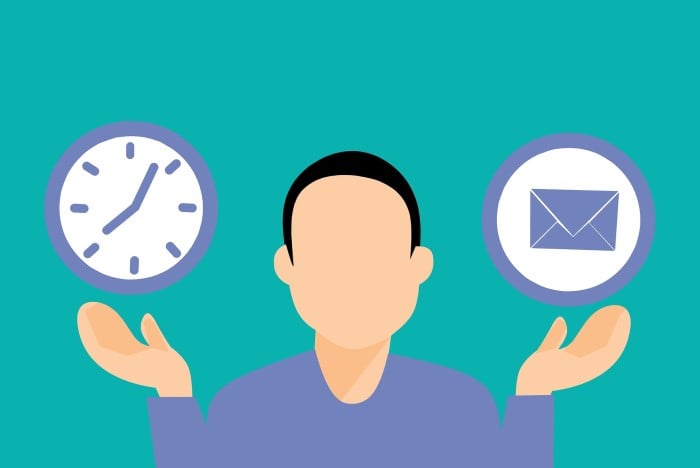
Your email should end with a sense of urgency. It’s not enough to say Buy Now! at the end of your email. There needs to be a reason for the reader to take action.
To encourage action, you can try different methods. Maybe there’s a special bonus, a percentage off, or a limited-time deal.
Offer your reader a nudge. Explain the benefits of taking action today instead of tomorrow. Remind them of the pain point they’re experiencing. If they act now, they’re closer to fixing whatever is causing their pain.
Often readers put off taking action, especially when they have to make a decision. Building urgency is not only helpful in increasing your sales, but it can move your customer toward an action that will benefit them.
11. Maximize Effectiveness with A/B testing
A/B testing your emails is a great way to see what works and what doesn’t in email marketing. You can quickly find out which headlines, body copy, and images get the best results.
To run an A/B test, create two different emails for the same campaign. One email will have the changes you want to test, and the other will be the control.
Send both versions of your email-one to each half of your targeted audience. (Your email service provider should have directions for this.)
After a few days, compare the results to see which version got more clicks, more opens, or more sales. Use this information to improve your future emails and your email marketing strategy.
Are You Ready to Put These Email Copywriting Tips to Work?
We shared 11 tips for your email copywriting that you can apply right away to get better results in your email marketing campaigns.
Email marketing has a huge return on investment and is one of the most cost-effective ways to reach your audience. But your emails need to be powerful to get results.
You’ve learned how to write persuasive emails that get results. Incorporate these tips into your email marketing campaigns today to write powerful emails that serve your audience and benefit your bottom line.
Which tip do you want to practice first?



